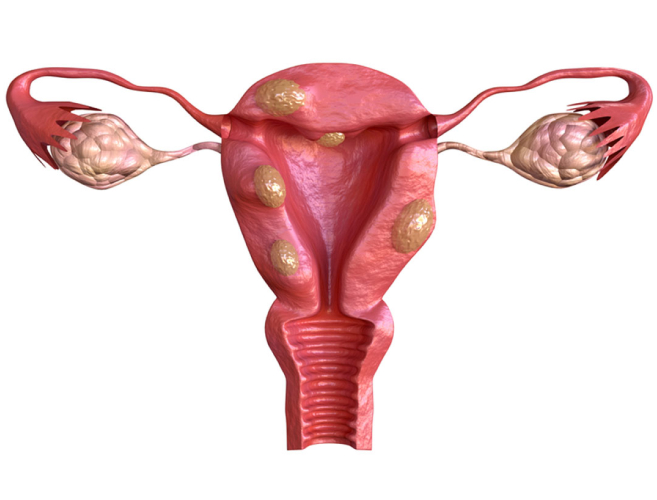Uterine Fibroids: Causes, Symptoms, Risk Factors, and Ayurvedic Treatment
Many women are affected by uterine fibroids, which are benign (non-cancerous) tumors that develop inside the uterus, particularly when they are in reproductive years. Although these growths are frequently asymptomatic, they can cause a variety of discomforts and health problems. They can also vary in size. The causes, signs, risk factors, and Ayurvedic treatments for uterine fibroids will all be covered in this blog.
What are Uterine Fibroids?

Muscular growths that form in the uterine walls are known as uterine fibroids, myomas, or leiomyomas. These fibroids can vary in size from tiny, seed-like growths to larger ones that can cause the uterus to become distorted. Usually made up of muscle and fibrous tissue, they are frequently categorized as submucosal, intramural, or subserosal fibroids according to where they are located in the uterus. Many women with fibroids may not have any symptoms at all, but some may have mild to severe symptoms. The general health and quality of life of a woman may be impacted by these symptoms.
Muscular growths that form in the uterine walls are known as uterine fibroids, myomas, or leiomyomas. These fibroids can vary in size from tiny, seed-like growths to larger ones that can cause the uterus to become distorted. Usually made up of muscle and fibrous tissue, they are frequently categorized as submucosal, intramural, or subserosal fibroids according to where they are located in the uterus. Many women with fibroids may not have any symptoms at all, but some may have mild to severe symptoms. The general health and quality of life of a woman may be impacted by these symptoms.
- Age and Ethnicity: Research indicates that African-American women are more likely than women of other ethnicities to have uterine fibroids, which are most prevalent in women between the ages of 30 and 40.
- Environmental Factors: The risk of developing fibroid may be raised by exposure to endocrine disruptors, such as pesticides and other chemicals.
- Way of living and Diet: Poor diet, obesity, and a sedentary lifestyle have been associated with an increased risk of developing fibroids.
Symptoms of Uterine Fibroids

The symptoms of uterine fibroids can vary depending on their size, location, and number. Many women with uterine fibroids do not experience any symptoms at all. However, when symptoms do occur, they may include:
- Heavy Menstrual Bleeding: Blood clots may accompanied by heavy periods or prolonged menstrual bleeding, one of the most prevalent symptoms.
- Pelvic Pain or Pressure: Pelvic pain, discomfort, or an enlarged abdomen are all possible symptoms of fibroids.
- Frequent Urination: Women who have fibroids pressing against their bladder may experience an increased urge to urinate.
- Painful Intercourse: Large fibroids, particularly those in the posterior region of the uterus, can make pain during sex.
- Infertility: Fibroids may occasionally affect a woman’s ability to conceive or cause pregnancy-related issues.
- Lower Back or Leg Pain: The fibroids may cause pain in the legs or lower back if they press against adjacent nerves.
Risk Factors for Uterine Fibroids
Although the precise cause of uterine fibroids is unknown, there are a number of risk factors that can raise your chance of getting fibroids:
- Age: Fibroids are more common in women in their 30s and 40s, particularly those who are approaching menopause.
- Family History: A woman’s risk of developing uterine fibroids is greatly increased if there is a family history of this condition.
- Ethnicity: Compared to Caucasian women, African-American women are more likely to develop fibroids.
- Obesity: A higher risk of fibroids is linked to being overweight or obese, possibly as a result of elevated estrogen levels.
- Hormonal Imbalance: Women who have higher progesterone and estrogen levels may be at a higher risk of developing fibroids.
Ayurvedic Treatment for Uterine Fibroids
Uterine fibroids can be treated holistically with Ayurveda, the traditional Indian medical system. The main goal of Ayurveda is to balance the body’s energies, or doshas, and encourage healing through the use of natural herbs, diet, and lifestyle modifications. In addition to reducing symptoms, ayurvedic treatments seek to improve general health by addressing the underlying cause of the fibroids.
Some Ayurvedic remedies for uterine fibroids include:
Some Ayurvedic remedies for uterine fibroids include:
- Herbal Remedies:
- Ashoka (Saraca asoca):

Known for its benefits in treating uterine disorders, Ashoka helps in reducing pain, inflammation, and regulating menstrual cycles.
- Shatavari (Asparagus racemosus):

- Often used to balance female hormones and promote reproductive health, Shatavari is also known to reduce the size of fibroids.
- Guggul (Commiphora wightii):

This herb is effective in managing inflammation and is commonly useds in Ayurvedic treatments for uterine fibroids.
- Turmeric (Curcuma longa):

Known for its anti-inflammatory and antioxidant properties, turmeric can help reduce the growth of fibroids and manage symptoms like pain.
-
Dietary Adjustments
A diet high in whole grains, fresh produce, and other nutrients can help balance hormones and lessen inflammation.
Fibroid growth can be prevented from getting worse by avoiding processed foods, too much sugar, and dairy
Antioxidant-rich foods, like berries and leafy greens, can aid in the body’s detoxification and healing.
-
Panchakarma Treatment:
This detoxifying method aids in the removal of toxins from the body and revitalizes the reproductive system. In order to control fibroid symptoms and stop additional growth, this may be helpful.
-
Yoga and Pranayama (Breathing Techniques):
Consistent yoga practice can lower stress, ease pelvic pain, and increase blood circulation. Controlled breathing, or pranayama, promotes relaxation and hormonal balance by balancing the body’s energies.
-
Lifestyle Changes:
Stress reduction via relaxation methods, meditation, and enough sleep can have a big impact on hormone balance and general health
Frequent exercise can help control weight and enhance circulation, especially low impact exercises like swimming or walking.
You can visit our Youtube channel to get knowledge about other Products.
To get more information click here

